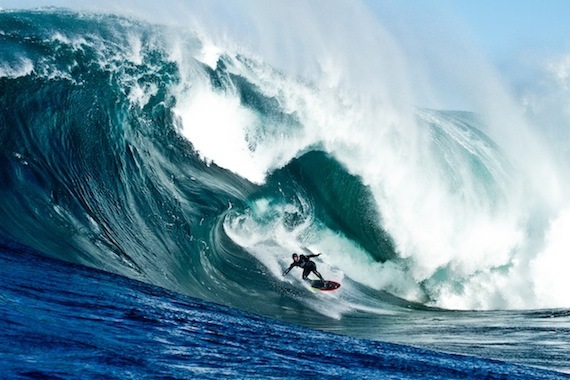If you're an adrenaline junkie, or just like to watch people do INSANE things on YouTube, you've probably heard of Garrett McNamara and his world-record setting ride of a 100ft wave. That's about the size of a ten story building. The wave, however, might weigh even more.
McNamara makes it look easy. Effortless, if you will. And whenever surfing is on the big screen, it often appears just as graceful and carefree. (I mean, just look at the Johnny Tsunami cover! That kid is having a BLAST!) If you talk to anyone who surfs in real life, they will tell you the adrenaline rush doesn't come solely from the fact that you are seemingly standing on water. It mostly comes from the fact that surfing might be one of the most dangerous sports in the world.
Obviously, the danger of sharks is self-explanatory. Then there's the possibility of drowning. The actual surfboard itself can destroy a surfer with its blade-like fin and pointed tip. Combine that with leash tangles, sharp reefs, and rip currents, plus the hundreds more I could list, and that adorable kid's movie about a surfing penguin becomes more of a horror film.
Now, take ALL of those dangers that come with surfing in perfect ocean conditions, and add them to the waves that appear with treacherous ocean storms. Riding waves that are over 20ft in height and completely unpredictable cause the risk level to skyrocket. A risk level that scares even the most experienced surfers out of the water.
However, surfers Tom Carroll and Ross Clarke-Jones see it as more of an adrenaline rush. Which is why they are hell-bent on finding and riding the biggest waves on the planet. Nicknamed "Storm Surfers," these dudes are the storm chasers of the sea, going to the ends of the earth to ride waves no one else dares to try. And while this might lead you to believe they are absolutely insane (and they might be), they are absolutely brilliant when it comes to being aware of their surroundings, and knowledgeable about what they are getting themselves into.

Ross Clark-Jones at Shipsterns Bluff in Tasmania. Photo: Andrew Chisholm
One thing they are deeply informed about are the waves themselves. It's difficult to deny how absolutely breathtaking a big wave can be, but what kind of power does it pack?
Watch how Storm Surfers calculate their risks in the video below:
When looking at an average big wave, each cubic meter of water weighs about 1 ton. If the wave is about 10 ft tall and the lip (top) of the wave is about 20 ft long, the wave itself weighs about 410 tons, which is equal to about 315 small cars.
That fact alone makes every ride the Storm Surfers take even more terrifying, and every calculation made while riding the wave can literally be the difference between life and death. Even if the sea bed isn't the typical rocky reef, a sandy bottom is essentially concrete when 315 small cars of water are crashing down on top of you.
Surfing is scarier than it looks, but the bottom line is, respect the ocean. There are risks, just as there are with every sport. But if you surf smart and surf safe, the high that comes from riding on one of the most powerful forces of nature is completely worth it.